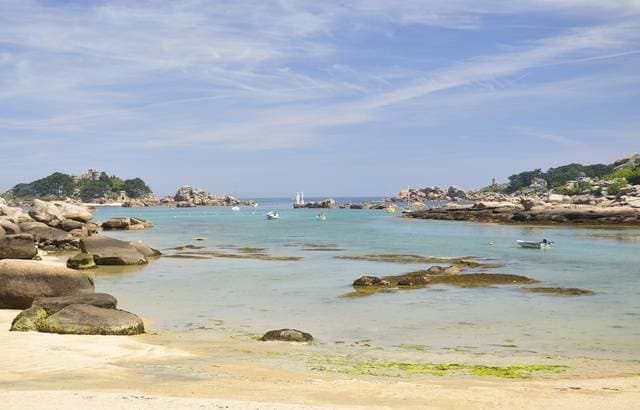EPIDEMIC: The Brittany region is the least affected by the coronavirus Covid-19 epidemic and sees its hospital pressure drop
- In Brittany, elected officials are calling for a reduction in the health measures imposed by the French state to fight against the coronavirus Covid-19 epidemic.
- The incidence rate is lower there than anywhere else and hospital pressure is decreasing.
- According to a doctor, gradual relief could be considered even if the reopening of bars and restaurants will undoubtedly have to wait.
The voices are more and more numerous. In Brittany, local elected officials are beginning to express their weariness in the face of restrictive measures imposed by the State to fight against the coronavirus epidemic. It must be said that the region is by far the least affected by coronavirus Covid-19. As of Friday, the regional incidence rate was 108 cases per 100,000 inhabitants. That is two times less than the national average and almost six times less than in the Alpes-Maritimes.
While some very affected territories are subject to tightening of measures, Brittany, on the contrary, would like to see its protocol lightened . “I am delighted that we can finally return to local, targeted measures. On the other hand, I do not understand that this territorialization cannot be carried out in the sense of a reduction of the measures, which remain very heavy and difficult to bear ”, launched the deputy of Morbihan Paul Molac during the last questions to the government .
In his department, he is not the only one to think this way. In Plœmeur, a charming town of 17,000 inhabitants adjoining Lorient, the mayor pleads for a gradual alleviation of constraints. “We have the opportunity to experiment, to set rules. Why not impose a threshold that would gradually reopen museums, theatres, and resume sport? When I look at the numbers, I have the impression that the situation would allow it. If it wasn’t, I wouldn’t consider it, ”explains Ronan Loas.
“We must not neglect the risk and not do anything”
Would it be possible to streamline the protocol in Brittany, but also in Pays-de-la-Loire or New Aquitaine, where the virus circulates less? 20 Minutes put the question to Professor Pierre Tattevin, head of the infectious diseases department at Rennes University Hospital. “It is legitimate to wonder and I understand these elected officials. We see that the government has a graduated response in the most affected territories. It would seem logical enough to have the same thinking in less affected areas, ”said the professor. For him, this progressive deconfinement, “it must be considered”.

If he allows himself to be so affirmative, it is because the doctor has a very good knowledge of the hospital pressure in the region. “At the Rennes University Hospital, we had up to 140 people in intensive care. We are currently at 110 so there is still a heavy workload. But the vaccination works very well and we see that the number of elderly people taken care of is tending to decrease ”.
So Brittany would be ready to reopen its many cafes and restaurants? Not so fast… “We must not neglect the risk and not do anything. Studies show that bars and restaurants are places of contamination because we do not wear masks there. I think we will have to wait a little longer. But why not reopen the cinemas, authorize outdoor sport… It would not be crazy, ”said Professor Tattevin.
Imagine that Finistère has an incidence rate close to 50 cases per 100,000 inhabitants. A figure that the Alpes-Maritimes reached for the last time in the heart of August, before the epidemic started to rise again and flared up in Nice and around. Meanwhile, the Breton territories only have a handful of new cases every day. “We see that it is increasingly difficult to get certain measures accepted. With the days getting longer and the good weather, it is difficult to enforce a curfew at 6 p.m. in territories where there are almost no positive cases, ”said the various right-wing mayor Ronan Loas, who hopes that the curfew will be at least shifted to 8 p.m. “I measure the weariness and exasperation of people who are struggling to adapt to strict measures,
At the first deconfinement, “it was a mess everywhere”
If Brittany is stepping forward as a volunteer to “experience” a gradual return to normality, should it fear a massive influx of visitors? The hypothesis is quickly swept aside. “It would not necessarily be a good idea to have a sudden influx of people from areas heavily affected by the virus. As we know, brewing can speed up circulation. But it is not the source that poses the risk, it is the behaviour, ”said Professor Tattevin.
Local elected officials think no less. “Anyway, people see each other, get together and we cannot forbid them. We saw it in Dunkirk where contaminations exploded after the carnival. You have to relax, but do it within a framework, ”said Ronan Loas. The mayor of Plœmeur remembers, in particular, the first deconfinement, where the population had suddenly found a “normal” life, in defiance of certain rules of distancing. “It was the bamboche everywhere”. In Brittany, the relief could even be territorialized to best match the reality of the epidemic. Everyone will easily understand that reopening the bars in Le Conquet would not have the same consequences as reopening the bistros in Rennes.




